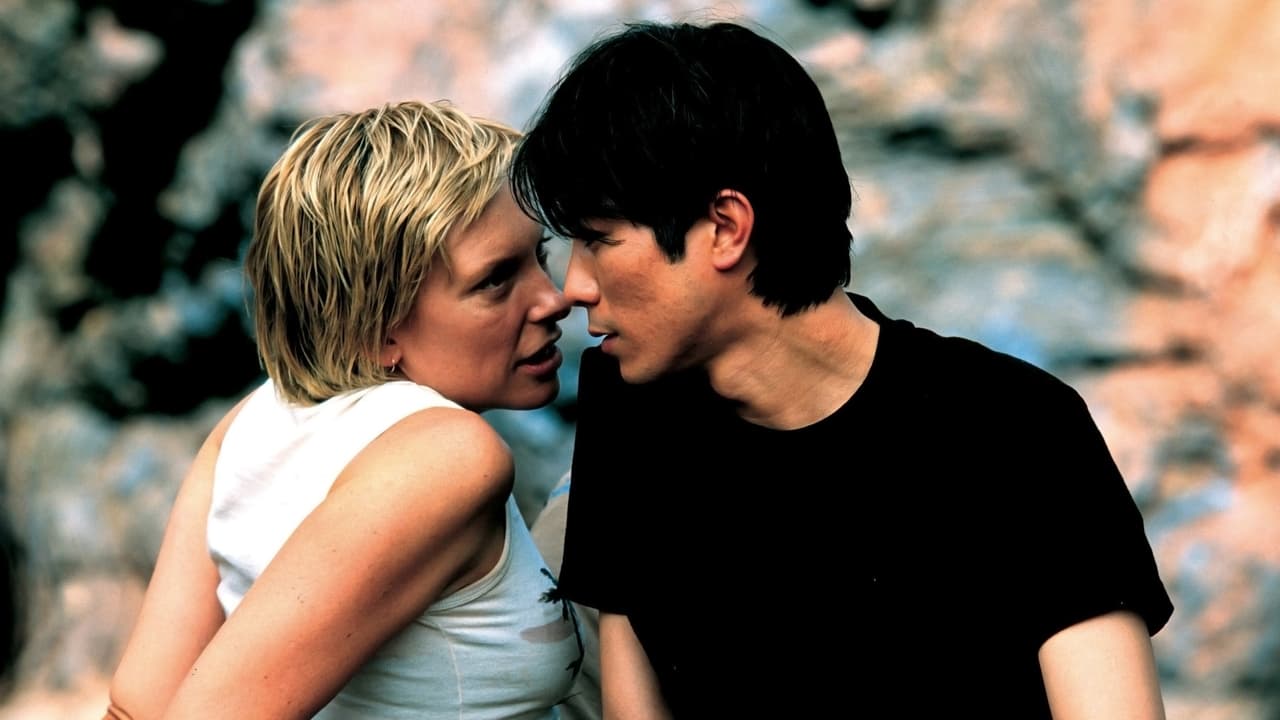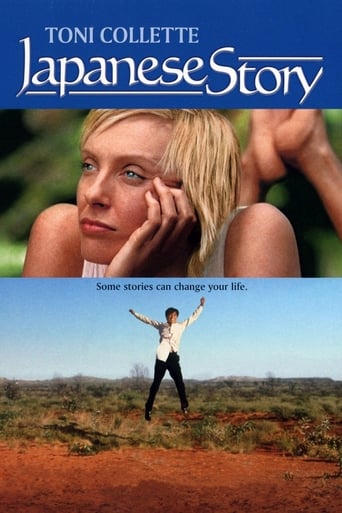

"The Outback is the vast, remote, arid area of Australia. The term 'the outback' is generally used to refer to locations that are comparatively more remote than those areas named 'the bush' which, colloquially, can refer to any lands outside the main urban areas. "Toni Collett is Sandy Edwards, an Australian geologist doing work for a large iron ore mining company owned by a wealthy Japanese industrial concern. The son of the owner is coming for a visit, they aren't quite sure why, but Sandy is asked to be his guide, to help him see what he wants to see.The Japanese son is Gotaro Tsunashima as Hiromitsu Tachibana, or 'Hiro' for short. Even though in real life he and Collett are just 6 months apart in age, he looks like he could be in his early 20s and she in her mid-30s. At first there is nothing but friction between them, he seems to think she is simply his driver, she sees him as a rude Japanese. For Hiro this seems to be the equivalent of a "walkabout". He is married with children, he mentions that he is under a lot of pressure, presumably to take over the company from his successful father. He seems to just want to see Australia, its vastness, its uniqueness, before he fully settles into his Japanese fate. At one point he muses, in the deserted outback, that Japan has so many people and little land, but here there is so much land and very few people. It is a revelation to him.Then comes the mutual bonding experience. He gets her to drive into an area they probably should not have, no cell phone signal and the 4-wheel drive SUV gets stuck deep, up to the axles, in red sandy soil. The winch burns out before pulling the vehicle out. It gets cold at night, they have to build fires to stay warm. But Hiro has an idea, maybe he can dig a path and line it with many small sticks, to get enough traction. It works, they are both joyous, and their personal barriers soften.Many will not like this movie because it is mostly slow, a character study, in vast and often featureless outback. But the actors are superb, and it mainly becomes the story of how Sandy can handle new love and grief. SPOILERS: At one point in their outback exploring, Sandy says to Hiro, "I'll introduce you to an Australian expression, 'last one in is a rotten egg'", as she pulls off her top and dives into a shallow secluded pool. Then we see Hiro go to a different spot, near some small trees, and as he dives in she shouts 'No, no, no, no, no, no' in quick sequence. He doesn't surface right away, and when he eventually does he is dead. She panics, she tries to resuscitate him. She finally has to drag his body to the SUV, get him to a town, finds an undertaker. She had fallen in love with this man from a strange country, they had slept together at least a couple of times, it seemed the feeling was mutual. In grief, the story ends as she is in the airport terminal building, watching the Quantas plane take off with Hiro's body in a casket aboard the plane.
... View MoreA Japanese businessman visits Australia and is given a tour of the land by a geologist, although they can't stand each other from the get go. Although it's not clear where the story is going, it becomes engaging as the relationship develops between the Japanese man and the Australian woman despite their cultural differences. About half way through the film, however, a random event takes place that totally changes the mood and direction of the movie. From that point on it just rambles aimlessly before finishing with a whimper. The two halves are like watching two different movies. It's just an odd script. Collette is fine as usual, as is Tsunashima.
... View MoreJapanese Story (2003)Toni Collette is such a natural on screen, ranging from bemused to chagrined with a single change in her face, and seeming so vividly present in every scene, she almost makes this movie work. Her male counterpart, little known Japanese actor Gotaro Tsunashima, is meant to be an uptight and restrained contrast, but he may take that intention the wrong way, making his character bland on screen. That the two have to first dislike each other, and then not dislike each other very much, depends on some kind of magic between the actors, or characters, which just doesn't exist.And then there is the plot. On paper it even looks a bit thin--two young people arrive on a mining island in the Pacific for different reasons (one from Australia, the other from Japan), and after butting cultural heads a bit, they head off in their Land Cruiser to an isolated part of the barren landscape. So far we follow. But the plot depends on them getting stranded out there, very far from everything (but perplexingly still in cell phone range!), and so the writers concoct some kind of need, which isn't really clear to me, to drive farther, mostly because he tells her to. And they do get stranded.And then they get stuck. Oh, right. And they spend the night together, he rises out of his selfish haze, they become lovers, and then, in a tropical paradise part of the coast, tragedy strikes. And there is the necessary coming to terms with all the repercussions. The final, long long shot of Collette in the airport is, by this point, utter hedonism on the director's part, and it dulls an already dragging film.You might be able to take in the unusual setting for the film, and enjoy Collette's strengths, and make it through okay.
... View MoreHaving seen this film at first release in a cinema, and enjoyed it, I was somewhat disturbed by some negative posts on this page. When the opportunity arose to see it on TV, then, I viewed it again. It's a bit more mysterious than I was aware of at first viewing. This could be because the two versions are different cuts. Perhaps the sound was better on my home cinema than I recall from the hardtop. Certainly, the story was well set in the opening scenes, when it is obvious that Sandy, the female IT specialist, is coming off an unsatisfactory relationship. As one of her colleagues remarks: "I don't know how anybody could do it with him". We then are aware that Sandy is "on the rebound" from that relationship. The unpleasantness of that experience is not helped by her being told to escort a visitor, Hiro, on a sightseeing trip for which neither is well prepared. This is where things get complicated. Sandy is a female in the blokey environment of outback mining, where the usual job for a woman is driving a large earthmover. Hiro treats her, not as a professional, but as his driver. On the phone he describes her to his wife as "She has a big bum and she talks loudly". When it becomes obvious that Hiro is clueless about outback motoring in his demand to be taken to inaccessible places, he secretively peruses Sandy's guidebook. At the same time, Sandy hides her Japanese phrase book inside a magazine. Their communication level in zilch. Sandy does most of the right things when they get into trouble, not knowing that Hiro has read at least one trick to get them going. Or does she deliberately leave that trick out of her lexicon? In any event, the episode does improve their communication level. To some, that is a mystery. In the finale, we see one of the basic rules of drama. Conflict is followed by changes in the characters. Sandy is less uptight, and we become aware that Hiro was in love with his wife all along. That is the mystery in "the letter". Why did Hiro's wife give Sandy the letter? We don't know, but remember that we have here a woman director and a woman writer. In any case, the wife and Sandy reconcile, as I suppose, two intelligent women would do in the circumstances. Viewers might care to check the lengths of the original film and the video version. This is a very watchable movie.
... View More